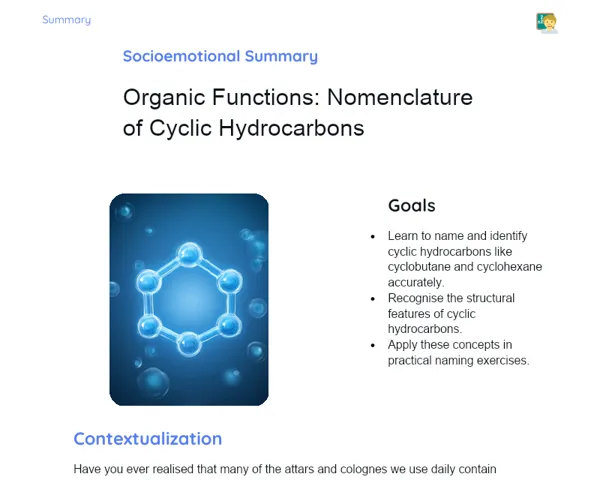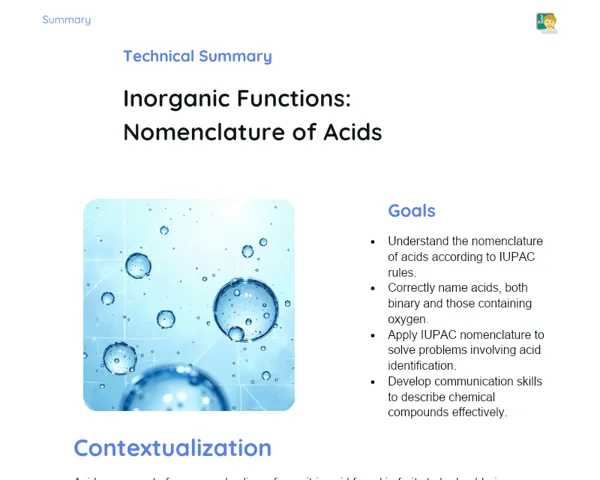Summary Tradisional | Concentration Units: Molality
Contextualization
In the realm of chemistry, grasping the concentration units is vital for diverse applications, ranging from industrial processes to the formulation of pharmaceuticals. Molality is one such unit of concentration, calculated as the number of moles of solute for every kilogram of solvent. This unit becomes particularly significant in scenarios where temperature fluctuations occur, as molality does not depend on the solution's volume but rather on the mass of the solvent. This feature makes it a preferred choice for chemical studies involving changes in temperature, such as endothermic and exothermic reactions.
In practical and industrial contexts, molality finds extensive use, particularly in the production of medicinal products. In pharmaceutical manufacturing, precision in concentration is key to ensuring the effectiveness and safety of the medications. Moreover, since molality remains stable despite temperature changes, it offers a dependable measure for examining chemical reactions under varying conditions. Therefore, having a solid understanding of how to calculate molality is an essential skill for both chemistry students and professionals alike.
To Remember!
Definition of Molality
Molality is a measure of concentration defined as the number of moles of solute per kilogram of solvent. The formula for molality is: m = n / m_solvent, where n indicates the moles of solute and m_solvent represents the mass of the solvent in kilograms. Unlike other concentration measures, like molarity, which are contingent on the volume of the solution, molality solely depends on the mass of the solvent.
This distinguishing characteristic makes molality incredibly valuable in scenarios where temperatures may vary since the solution's volume can change with temperature, while the solvent's mass remains constant. Thus, molality becomes the optimal concentration unit for investigating chemical reactions involving thermal variations, such as endothermic and exothermic processes.
Molality is widely applied across various fields of chemistry and industry. For example, during the production of medications, accurate concentrations in solutions are crucial for their effectiveness and safety. Molality offers a reliable and stable measure, despite thermal variations, thus streamlining the control and standardization of industrial operations.
-
Molality is defined as the number of moles of solute per kilogram of solvent.
-
The formula for molality is m = n / m_solvent.
-
Molality is independent of the solution's volume, focusing solely on the solvent's mass.
Importance of Molality
Molality is particularly significant in contexts where temperature varies since it is not influenced by the solution's volume but rather by the mass of the solvent. In cases where temperature can alter the volume of a solution, molality provides a more precise and trustworthy measure of concentration.
A notable advantage of using molality lies in its applications for studying endothermic and exothermic reactions. These types of reactions involve heat absorption or release, leading to temperature changes within the solution. Because molality remains unchanged despite such thermal variations, it serves as an ideal concentration measure for monitoring and analyzing these reactions.
Additionally, molality is extensively employed within the pharmaceutical sector to ensure the accuracy of drug formulations. The correct concentrations of active ingredients are essential for ensuring medications are effective and safe, and molality delivers a stable and reliable measure, irrespective of temperature conditions.
-
Molality is valuable in contexts with temperature fluctuations.
-
It effectively supports studies on endothermic and exothermic reactions.
-
Molality is key in the pharmaceutical industry to ensure drug formulation accuracy.
Practical Examples of Calculating Molality
To compute the molality of a solution, the formula m = n / m_solvent is utilized, where n stands for the moles of solute and m_solvent is the mass of the solvent in kilograms. Let's go through a couple of practical examples to illustrate how to calculate molality.
Example 1: Calculate the molality of a solution in which 5 moles of NaCl are dissolved in 2 kg of water. Applying the formula, we get m = 5 mol / 2 kg = 2.5 mol/kg. Therefore, the molality of the solution is 2.5 mol/kg.
Example 2: In another example, if we dissolve 10 moles of glucose (C6H12O6) in 5 kg of water, we can apply the same formula. Here, we have m = 10 mol / 5 kg = 2 mol/kg. Thus, the molality of the solution is 2 mol/kg.
-
The formula for molality is m = n / m_solvent.
-
Example 1: 5 moles of NaCl in 2 kg of water results in a molality of 2.5 mol/kg.
-
Example 2: 10 moles of glucose in 5 kg of water produces a molality of 2 mol/kg.
Comparison with Other Concentration Units
Molality is just one of several concentration units used in chemistry, each with distinct characteristics and specific uses. Other common units include molarity and mole fraction. Each unit has its advantages and disadvantages, depending on the context of their application.
Molarity (M) is defined as the number of moles of solute per liter of solution. Although molarity is beneficial in various lab scenarios, it is dependent on the solution's volume, which can fluctuate with temperature. This variability can lead to inaccuracies in experiments that involve thermal changes, unlike molality.
Mole fraction represents the ratio of the number of moles of a particular component to the total number of moles of all components in the solution. Even though this can be useful for describing solution compositions, mole fraction does not offer a direct concentration measure in terms of mass or volume, particularly unlike molarity and molality. To summarize, the selection of a concentration unit relies on the specific requirements of the study or application.
-
Molality can be compared with other units like molarity and mole fraction.
-
Molarity is dependent on the volume of the solution, whereas molality focuses on the mass of the solvent.
-
Mole fraction indicates the proportion of moles of one component to the total moles in the solution.
Applications of Molality in Real Problems
Molality is widely utilized in numerous practical and industrial scenarios, particularly where precise concentration is vital, such as in drug manufacturing. The pharmaceutical sector relies on exact concentrations to guarantee the efficacy and safety of products, and molality provides a constant and reliable measure, irrespective of temperature changes.
Moreover, molality is critical for investigations involving endothermic and exothermic reactions, where the solution's temperature may alter significantly. Its stability with respect to temperature variations enables meticulous monitoring of these reactions, ensuring consistent and dependable outcomes.
Another significant application of molality is in preparing standard solutions for laboratory experiments. Precision in formulating these solutions is fundamental for achieving consistent and reproducible results, and the reliability of molality as a temperature-independent measure facilitates control and standardization in numerous experimental setups.
-
Molality is essential in drug manufacturing for maintaining concentration accuracy.
-
Its stability with temperature changes makes molality crucial for studying endothermic and exothermic reactions.
-
Molality is employed in creating standard solutions for lab experiments, ensuring consistent and reproducible outcomes.
Key Terms
-
Molality: A concentration measure defined as the number of moles of solute per kilogram of solvent.
-
Solute: The substance that is dissolved in a solvent to create a solution.
-
Solvent: The substance that dissolves the solute, thereby forming a solution.
-
Molarity: A concentration measure defined as the number of moles of solute per liter of solution.
-
Mole fraction: Indicates the ratio of moles of one component to the total moles in the solution.
-
Endothermic reactions: Chemical reactions that absorb heat from their surroundings.
-
Exothermic reactions: Chemical reactions that release heat into their surroundings.
Important Conclusions
In this lesson, we delved into the concept of molality, including its definition and significance in the field of chemistry. We learned that molality is a concentration unit defined as the number of moles of solute per kilogram of solvent, and its importance shines in scenarios where temperature might fluctuate, as it remains unaffected by the volume of the solution. We also discussed the practical applications of molality, including its role in drug manufacturing and in the study of endothermic and exothermic reactions. The comparison with other concentration units, such as molarity and mole fraction, highlighted the specific advantages of molality in various contexts.
The relevance of understanding molality is evident, as it offers a stable and dependable measure of concentration in numerous practical scenarios. Accurate concentration is crucial in many sectors, notably in pharmaceuticals, where the effectiveness and safety of medicines hinge on precise concentrations. Additionally, molality is indispensable for the monitoring of chemical reactions involving thermal variations, enabling finer control and yielding more consistent results.
We encourage students to further explore the topic of molality and its diverse applications. Mastering molality and being able to apply it in practical situations is an essential capability for chemistry students and professionals alike. This understanding is not only vital for academic prosperity but also for honing practical skills that are highly sought after in the job market.
Study Tips
-
Review the concepts and formulas tied to molality, especially m = n / m_solvent, and practice solving a variety of problems.
-
Compare molality with other concentration units like molarity and mole fraction to gain a clear comprehension of their respective benefits and drawbacks in differing contexts.
-
Investigate the real-world applications of molality, particularly in drug manufacturing and in chemical reactions that involve temperature fluctuations, to grasp the significance of this concept in practical situations.


